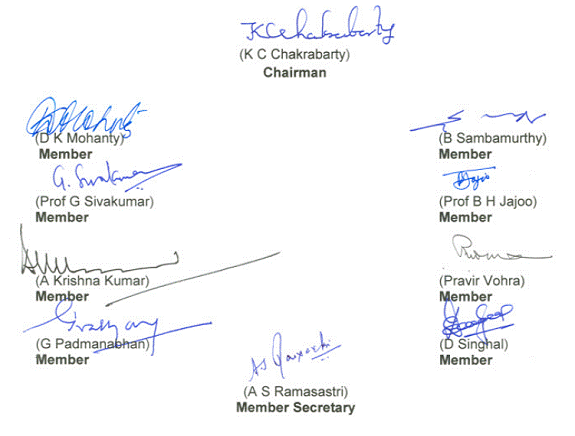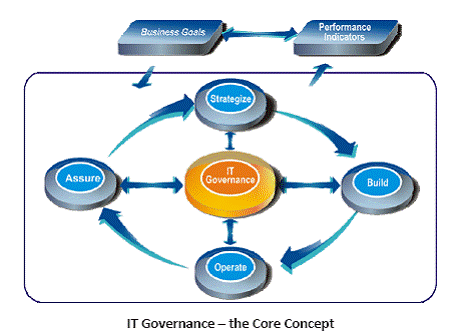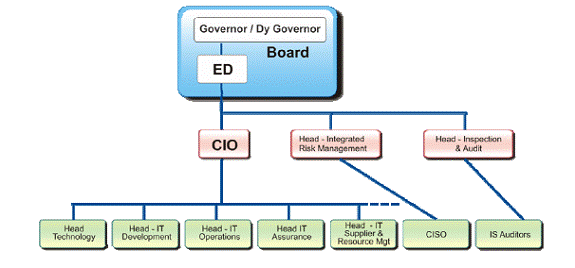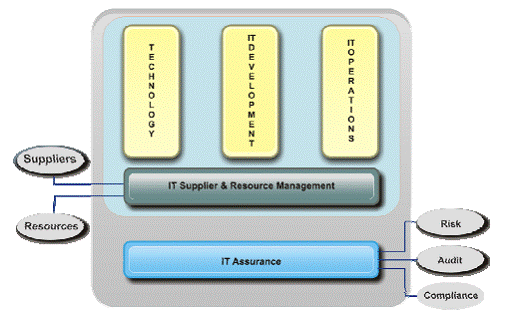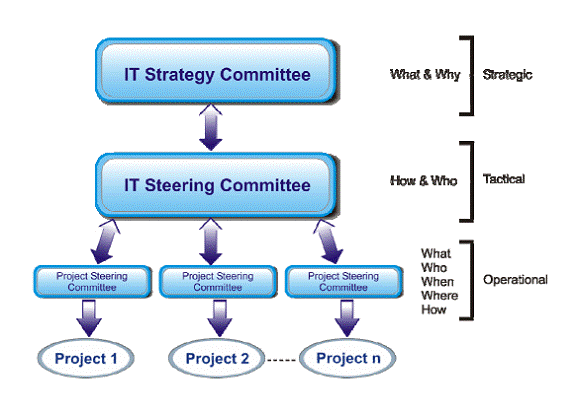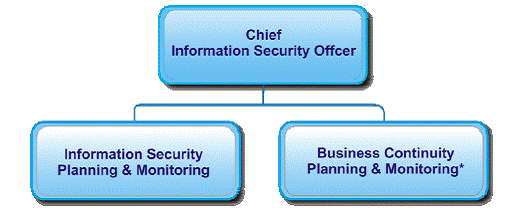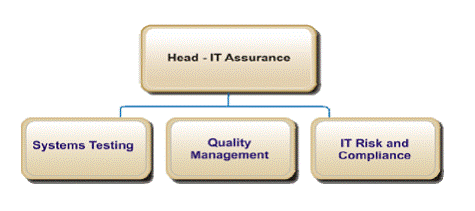 IST,
IST,
High Level Committee for Preparation of the Information Technology Vision Document 2011-2017
Deputy Governor LETTER OF TRANSMITTAL TO THE GOVERNOR
Dr. D. Subbarao, Sir, High Level Committee for preparation of the Information Technology Vision Document : 2011-17 I have immense pleasure in submitting the Report of the High Level Committee appointed vide Memorandum dated February 16, 2010, for preparation of the Information Technology Vision Document 2011-17. The spirit of the document is to guide the Reserve Bank for transforming itself into an Information intensive knowledge organisation. The members of the Committee have shared their rich experience and expertise during their deliberations, and have been unanimous in their views and recommendations. On behalf of the Members of the High Level Committee, and on my own behalf, I sincerely thank you for entrusting this responsibility to us.
High Level Committee for preparation of the
Chapter 1 1.1.1 Information Technology (IT) has transformed the conduct of businesses in every sector of the economy. Financial sector is one such area where the touch of IT has completely overhauled the nature and accelerated the pace of business. IT has been instrumental in improved communication and connectivity across all segments/players of this sector as well as in enhancing the quality, efficiency and speed of delivery of financial services. The Reserve Bank has played a pivotal role in this process of transformation of the financial sector with the use of IT. As the central bank, the Reserve Bank has strived to create a conducive environment for promoting technological adoption encompassing the financial sector. Moreover, being an important institution in the financial sector, it too has undergone the process of technological change. Finally, the Reserve Bank has endeavoured to streamline technological change in a manner that would help to enhance the inclusiveness of the financial sector. 1.1.2 While technology has become an integral part of conducting and managing business in the financial sector, it can hardly ever be characterised as static. It has evolved over the years and it is important, therefore, that the financial sector too reviews these developments and adapts itself to the same. It is in this context of review and adaptation to technology that the information management requires specific attention. 1.1.3 The Department of Information Technology (DIT) of the Reserve Bank was formed in 1995 to exclusively to look after the Reserve Bank's requirements in the field of computerisation and modern communications network and undertake advance planning for technology upgradation in the banking sector. Over a period of fifteen years, DIT has satisfactorily fulfilled most of the objectives set to it at the time of formation. It has been instrumental in designing, developing and implementing IT-based systems, which have helped in the discharge of various functions of the Reserve Bank. 1.1.4 During this period, several developments have taken place in the realm of IT and its adoption in the banking sector. The developments largely relate to improvements in back office management in the form of streamlining Management Information System (MIS), strengthening centralised processing and improving communication networks. As these developments have a bearing on the role, functions and organisation of the Department, it is necessary to review the objectives of DIT in the light of these developments. 1.1.5 To steer the financial sector to achieve the desired technological goals, the Reserve Bank has brought out two vision documents encompassing the periods 2005-08 and 2008-10. As the tenure of the previous IT vision document was 2008-10, it was incumbent upon the department to prepare the next version of the vision document for the period 2011-17. 1.2 Constitution of the High Level Committee (HLC) 1.2.1 It was in the above background that a HLC was constituted to prepare the IT Vision for 2011-17. The objective was to identify the information needs of the Reserve Bank as also to work on the changes to the organisational structure of DIT. The terms of reference for the Committee were the following:
1.2.2 As the terms of reference covered diverse and specialized areas, there was a need to associate experts with varied backgrounds from within and outside the Reserve Bank to conduct the review. Accordingly, the Committee was formed with the following members: Dr K.C. Chakrabarty, Deputy Governor, RBI: Chairman 1.3.1 The prime focus of the Committee has been on the preparation of the IT Vision Document for the Reserve Bank of India for the period 2011-17. For this purpose, the Committee had taken into consideration the issues, challenges, evolving technology and changing business environment. In addition to preparing the Vision Document, the Committee had also given specific recommendations for its operationalisation. As DIT is responsible for adoption of IT in the Reserve Bank, the Committee reviewed its activities during the past fifteen years. The Committee recognised the need for extensive use of information for decision making, identified the gaps and put forth specific recommendations in terms of systems and structure. Based on the review of its past activities and its evolving role for development of information systems, the Committee has given recommendations on the future role, responsibilities and organization of DIT. 1.3.2 Three sub-groups were formed to concentrate essentially on the terms of reference and recommend the measures to accomplish them, as follows:- (a) Sub-Group on preparing IT Vision for the Reserve Bank for 2011-2017: Members: (b) Sub-Group on specifying the role of the department in meeting the information needs of the Reserve Bank in particular and the society in general. Members: (c) Sub-Group on redefining the role, responsibilities, functions and organization of DIT Members: Convenor:
1.5.1 The Member-Secretary of the Committee, Dr A S Ramasastri has worked with a missionary zeal, and ensured that the quality of the report is not compromised while pursuing the large agenda that encompassesvarious facets of central banking. His involvement in the preparation of the three sub-group reports and in getting them organized into the Committee report is commendable. The Committee would like to record its appreciation for his dedicated work. 1.5.2 The members of the three sub-groups have given their valuable time in providing very useful inputs and the convenors worked diligently to produce reports of high quality. The Committee acknowledges its gratitude towards their contribution. The Committee wishes to record its appreciation to the teams consisting of the following officers in preparation of the reports:
1.5.3 The secretarial support to the Committee was ably provided by the Department of Information Technology, Reserve Bank of India. Smt Shubhangi V Latey, Manager, Shri S Shamej, Manager, Shri M. Mahesh, Assistant Manager deserve special mention in this regard. Shri Himanshu Joshi, Director, DEPR and Smt. Pallavi Chavan, Assistant Adviser, DEPR gave valuable inputs in editing the Report. 1.5.4 Finally, the Committee wishes to place on record the commendable work done by Smt Nikhila Koduri, DGM, and Smt Dipti Vishwanathan, Manager who have been associated with the work of the Committee right from organising the meetings to collating information from various sources and finally in the preparation of the draft report. Chapter 2 2.1 Changing Environment and Challenges ahead 2.1.1 Over the years, the functions of the Reserve Bank and its focus have evolved in response to the changing economic environment. While discharging its traditional functions, the Reserve Bank has been in the forefront of adopting new initiatives. These new initiatives required adoption of appropriate technology to deliver optimal solutions and in the process increased the need to plan and implement newer IT strategies. 2.1.2 Simultaneously, there have been changes in the technology environment. The Reserve Bank is committed to create adoption of newer technologies. In this context, cloud computing, virtualisation and open source technologies can be used for driving efficiencies of operation and reducing costs to customer. By using cloud computing, the service providers can deliver a variety of IT enabled capabilities to the customers. 2.1.3 The adoption of technology has brought in efficiency in the payments systems operated by the Reserve Bank. This can be measured by the increasing use of electronic mode of transmission of money by customers of banks. Adoption of Core Banking Solutions has emerged as a single most significant innovation which has transformed the way banks have managed their businesses. However, these systems have not been fully exploited for information management and decision support. Similarly, the IT governance structures are yet to be fully strengthened. 2.1.4 In the context of (a) increased demand on IT solutions (b) changing technology scene and (c) gaps in adoption of technology to meet the information needs, the Committee has identified the specific areas that need to be addressed during the ensuing years. These issues may be addressed in the short, medium and long term. Some of the important issues are delineated below:
The Committee has taken into account the above challenges while preparing the IT Vision Document 2011-17. 2.2 The IT Vision Document 2011-17 is enclosed. 2.3.1 Keeping in view the goals identified in the Vision Document, and taking into account the steps required to operationalise the same, the HLC has reviewed the activities of DIT during the past 15 years and identified the information needs of the Reserve Bank and society and has recommended certain changes in the present role, responsibilities, functions and organization of the department. 2.3.2 DIT may be entrusted with the responsibility to identify the specific action points and prepare action plans for short, medium and long term implementation. For this purpose, the department may use the recommendations given by the Committee in this report. Further, the department may coordinate with other departments of the Reserve Bank and also external organizations to achieve the goals set in the Vision Document. 2.3.3 A high level standing committee at the top management level may be formed to monitor the progress of implementation of IT Vision Document. Chapter 3 3.1.1 Following the macroeconomic and structural reforms undertaken from July 1991 onwards, it was important for the Reserve Bank to gear up its internal Information Technology (IT) set up for an effective handling of the new tasks that were devolved on it. The Reserve Bank undertook a number of steps to exploit the rapid strides in the field of computers and communications towards improving efficiency, productivity and customer services not only within its own organisation but also across the banking sector as a whole. 3.1.2 In order to focus on planning and implementation of computerised systems, a department known as the Department of Information Technology (DIT) was set up on January 1, 1995. The department was mandated to service the technology needs of the Reserve Bank and serve as a facilitator in the deployment of IT in banks and the financial sector. It was also entrusted with the responsibility of r facilitating reforms in the Payment and Settlement Systems of the country, a role it played till the constitution of a separate department called Department of Payment and Settlement Systems (DPSS) in March 2005. The mission of DIT was to function as the nodal agency for technological improvements and for achieving operational excellence both within the Reserve Bank and in the banking sector, and to implement a safe, secure and efficient integrated payment and settlement system for the country. DIT was carved out of two divisions of the erstwhile Department of Statistical Analysis and Computer Services (DESACS) viz. Computer Operations Division and Systems and Programming Division which were merged with the erstwhile Management Services Department. The functions of DIT went beyond those of its constituent units. The functional areas of DIT were broadly grouped as following: 3.2.1 Computer Technology: This included:
3.2.2 Communication Technology: This included:
3.2.3 Payment systems and Technology upgradation: Monitoring of upgradation of technology in Public Sector Banks (PSBs) included progress in the development of an integrated and robust Payment and Settlement system and implementation of the decisions of the Payment System Advisory Committee. It also included:
3.2.4 Coordination with banks: Monitoring the progress achieved by public sector banks in computerisation and informing the Government of the same. 3.2.5 The other functions of DIT included:
3.3 Activities during various phases: Initial efforts within the Reserve Bank were aimed at mechanisation of activities in the 1980s which expanded into computerisation of its critical operations in the 1990s. The next decade marked a phase of consolidation, with renewed thrust towards putting in place comprehensive systems following the generic architecture and providing solutions to enhance the efficiency of the payment and settlement systems in India. The broad approach followed in implementation of IT initiatives centred around the need for having homogenous IT systems catering to varied processing requirements of the Reserve Bank and providing for seamless integration across the various applications, wherever feasible. Recognising the need for distributed computing across the various locations of the Reserve Bank and taking advantage of the benefits of centralised processing in an IT environment, DIT adopted the approach of ‘Centralised Processing with Decentralised Access’. While managing technology implementation was a major activity which had to be handled by DIT, managing and imbibing the rapid developments taking place in the field of technology was a bigger challenge. Though hardware-related technological obsolescence has not greatly impacted the progress achieved, there have been issues related to software obsolescence. Some of the notable developments which have taken place during the last fifteen years of DIT’s operation are as follows: 3.3.1 Formative Phase: 1995-2000 In the initial period, DIT brought into focus the need for quick and efficient use of new technologies in the Bank in the areas of:
3.3.2 Stabilisation Phase : 2000-2005 During this period, the focus of DIT shifted to stabilising the responsibilities/projects that were entrusted to it. The main areas of work related to the following:
3.3.3 Maturity phase: 2005- till present During this period, the major activities conducted / overseen by DIT were the following: i. Payment and Settlement Systems:
ii. Infrastructure:
iii. Non-Payment Applications i.e. Human Resources Management System (HRMS), Integrated Establishment System (IES), Mail Messaging System (MMS), Enterprise Knowledge Portal (EKP) and Document Management Information System (DMIS) were also implemented thus heralding a new generation of applications for the use by every staff member of the Reserve Bank. This period also saw the introduction of Smart card-based access control system as also connectivity of all Reserve Bank offices by the video conferencing facility. Migration of Secured Internet Website to a centralised system at the data centre was also undertaken. iv. Miscellaneous: There was an effort towards ensuring constant availability of services by effective and failsafe Business Continuity Plans (BCP) and hence, periodical BCP exercises were undertaken. Information Security policy put in place. There was adoption of Core Banking Solutions (CBS) by almost all the banks. 3.4.1 From the above, it can be seen that DIT has accomplished the tasks entrusted to it, particularly those relating to the building of efficient and secure payment systems. It has also put in place a fairly robust IT infrastructure in the form of data centres, Local Area Network (LAN) and Wide Area Network (WAN). Over the last decade and a half, attention has been focused particularly on operationalising and maintaining the payment systems in a safe, secure and efficient manner. Consequently, the implementation of distinct information systems to support decision making activities and re-engineering the business processes could not be accorded equal priority. Chapter 4 4.1 Existing Setup 4.1.1 Information Systems in the Reserve Bank The existing system of gathering information in the Reserve Bank is based on the functions / roles performed by it. Various departments play a contributory role in collection of information. Information is also collected from external sources. The present data collection systems in various departments are disparate and are at different levels of automation. The Bank has started a process of bringing all such systems to single interface in the form of On-line Returns Filing System (ORFS). Currently some returns are already under ORFS while efforts are on to bring others in its fold. There are consistent efforts to set standards for data reporting in the form of eXtensible Business Reporting Language (XBRL). XBRL taxonomies have already been developed and implemented for Basel II return. Most of the information collected or generated in various departments flows into the Reserve Bank’s Enterprise Data Warehouse (EDW). The EDW also contains data of 72 countries which are members of the BIS Data Bank. The process of flow of data from various systems to EDW is getting automated. There are still manual procedures in the data flow from several systems. As an information sharing mechanism, this system, provides consistent time series on broad spectrum of macroeconomic variables. However, departments still rely on their respective systems for meeting regular reports / ad hoc queries. As a result, the facilities provided by dash boards and business analytics are yet to be fully exploited. The Enterprise Knowledge Portal (EKP) is fast emerging as a robust information and collaborative channel for sharing information within the organization. 4.1.2 Information Systems for Society Market participants/ analysts/ academicians/ other professionals rely heavily on the information provided by the Reserve Bank. In addition to the regular publications in the printed format, Reserve Bank is also providing information to the public through its website. By providing access to the general public for the publishable part of the data warehouse over the internet through a link Data Base on Indian Economy (DBIE), a beginning has been made towards the real-time dissemination of data to the society. With institution of ‘Real Time Hand Book of Statistics on Indian Economy’ in 2009, the scope of this work has been further broadened. There have been several changes in the financial sector both domestically and internationally, necessitating collection of data to meet the new requirements of regulation and policy making. Further there have been changes in the technology for collection of data and dissemination of information. Therefore, there is a need to review the existing systems in the Reserve Bank, based on the principles of information management, information technology and information governance. After examining the present data and information management systems in the Reserve Bank, the Committee identified following issues and concerns to be addressed: 4.2.1 Information Management: One of the major objectives of information management is to collect, process, compile and analyse data in a timely manner for taking policy decisions. However, at present, a strong linkage in the use and sharing of information for decision making is missing within the Bank. This, to some extent, has bred information illiteracy within the organisation. Hence, in order to make policies based on timely and correct data, the following issues need to be addressed : i. Data Quality: Presently, the data reported to Reserve Bank is not necessarily forwarded from the centralised system or the MIS servers of banks. Manual intervention often leads to incorrect reporting. This raises doubts on the genuineness of data management. Policy decisions based on such data may be erroneous. ii. Data Definition: There is no metadata available encompassing all the returns received by the Reserve Bank. The EDW has its own metadata and it covers statistics only conforming to this data. iii. Timeliness: While regulatory returns are received well in time due to their statutory nature, statistical returns, which are more granular in nature, are received with considerable time lag limiting their use for policy decisions. iv. Availability: All data in the Reserve Bank is not ported to the EDW. Further, users are not aware of the availability of data. The EDW is not used optimally. v. Accountability: Often there is no accountability for the data submission. vi. Coverage: Though the data captured in the Reserve Bank from primary and secondary sources is satisfactory, there are some data gaps in the coverage and these need to be adequately addressed. vii. Data dissemination: This needs to be strengthened in the areas of:
4.2.2 Information Technology i. Various departments of the Reserve Bank have their own disjoint data management systems that lack the capability of data analysis. ii. Reserve Bank still relies excessively on paper-based documents which are preserved in physical files. There is no fully IT enabled system, wherein internal notes are prepared, authorised electronically using digital signatures and stored in a networked server for future retrieval. iii. Aggregation and Distribution of information pose a challenge. iv. Cyber attacks and newer forms of security threats pose challenges. 4.2.3 Information Governance The concerns and issues regarding data and information can be addressed by having a proper governance structure in place with respect to the data, information, security and information technology. There is an overarching need for adoption of principles of integrity, accessibility and security for setting the appropriate benchmarks. After examining the issues and concerns that need to be addressed, the Committee recommended the following: 4.3.1 Information Management i. The quality of data received in Reserve Bank needs to be improved for its use in decision support system. The generation of required data directly from the transaction processing system at the bank’s end and automating flow of such data to the Reserve Bank without any manual intervention in a straight through process is recommended. ii. While respective departments who have prescribed the return/ statement should be the owner of the received data, the data should reside in the central repository. iii. A comprehensive assessment of the Reserve Bank’s information architecture needs to be done to help identify potential inefficiencies. A complete list of data items, their definitions, concepts and metadata for all the data collected and maintained by the Reserve Bank should be compiled and prepared. iv. All data managed by the Reserve Bank to move to the EDW on a near real time basis. v. In the Reserve Bank, the culture of using data and information for policy making needs to be encouraged. vi. Information hubs across departments with built-in safeguards. vii. Real time links to be provided between RBI and Financial Institutions to facilitate remote examination. viii. Reserve Bank may equip itself to make virtual visits to banks. 4.3.2 Information Technology i. There is a need to adopt efficient IT solutions, which can be enabled to improve methods of data submission, receipt of data for staging purpose, transfer of clean data for appropriate access and analytical capability to the stored data. ii. The Reserve Bank needs to encourage use of more technological solutions such as business intelligence tools, business analytics, data mining tools and semantic search for analysis of data. iii. Reserve Bank may also implement the second generation intelligent data warehouse. iv. The Reserve Bank to move to a fully IT enabled workflow and document management system thus paving the way for a less-paper environment. v. Use of DSS for MIS to be encouraged. vi. RBI to be constantly remain vigilant to security threats and keep in touch with agencies like CERT-IN etc for prevention of cyber attacks. 4.3.3 Information Governance i. It is suggested to put in place policies/guidelines in the following areas:
ii. Comprehensive guidelines on the data quality and uniform data reporting standards to be prepared. iii. Data dissemination policy may be put in place to ensure that the requisite data is available to the users. iv. Management of received data should be with one department with expertise in IT. This will enable harnessing the latest available technology. 4.4 Role of DIT, DSIM and other departments To carry forward the above recommendations, the Committee suggests the following : i. DIT needs to provide technical support to all the information system initiatives and the necessary IT infrastructure. ii. Receipt of data from all sources should be consolidated at a common repository at the Reserve Bank. iii. An inter-department group to be formed for examining, overseeing and implementing new data requests. iv. Each Central Office Department (COD) and Regional Office (RO) of the Reserve Bank need to have a separate unit to cater to their information needs. A nodal officer needs to be posted in each COD/RO for coordinating with the central department which is maintaining the central data repository. v. The nodal officer of the COD unit to have the responsibility of maintaining accuracy, consistency, completeness, and updating of data. The responsibility of the nodal officer may also include:
vi. The nodal officer of the RO units to coordinate with the local bank branches in cases of training and conducting surveys among banks and other financial entities. vii. Data supply to any other entity needs to be routed through central data repository i.e. EDW. The EDW and its internet portal Database on Indian Economy (DBIE) may be the predominant platform for data dissemination internally as well as outside the Reserve Bank. Chapter 5 5.1 Present structure: Based on the roles, responsibilities and functions of DIT, the department is presently organised into the following divisions :
5.1.1 In addition to the divisions at Central Office, the Department operates and maintains three data centres namely Primary data centre, On-City data centre and Off-City data centre. 5.1.2 Presently the staff in DIT is a complement of the DSIM cadre and general side officers. Although there is no separate IT cadre in the Bank, officers with either IT background or aptitude to work in an IT environment are considered to be posted to DIT. There have been some efforts by the Reserve Bank to employ people with IT background through a special recruitment / contract appointment. 5.1.3 The present IT Vision Document 2011-17 provides the genesis for reviewing the functions and consequently the organisation structure of this department. 5.2 Issues faced by the department : After examining the present roles, responsibilities and functions as also the organisation structure of DIT, the Committee observed the following issues posing challenges to the department. These issues grouped under related heads are enumerated below : 5.2.1 Policy related i. Governance: There are inadequacies in structure in the areas of IT governance, information governance, data governance, information security governance. ii. Policy Formulation: For ensuring overall efficiency of the IT systems, there is a need for periodical reviews of information and security policies encompassing data and information governance, information security, IT, audit of IT processes and infrastructure. 5.2.2 Process related
5.2.3 HR related There is no separate IT cadre in the Reserve Bank. However, the Reserve Bank had earlier recruited a few IT specialists and had also employed a few on contract basis. In view of the transfer and placement policy of the Reserve Bank, it is not possible to keep officers posted to DIT on a permanent basis. The new entrants to the department, particularly those identified to work at data centres or with specific applications take a longer time to acquire the necessary skill sets. Thus, it has been difficult to identify officers with the right aptitude to work in the IT environment in the Reserve Bank. There is an alignment mismatch between IT and HR related issues. Based on the issues discussed above, the Committee recommended the following : 5.3.1 Policy related i. A high level multi-disciplinary / multi-departmental group may be entrusted with the preparation of various governance framework/structure/prepare appropriate policies as mentioned above for the Reserve Bank. DIT may provide the secretarial services for this high level group. ii. RBI may consider constituting a top level body with external technical & domain expertise to address bank wide IT strategy, plan and standards. iii. In order to put in place the above governance frameworks, there is a need to define and assign the following roles in the Reserve Bank:
5.3.2 Process related i. A department/division may be entrusted with the responsibility of BCM which would include Business Impact Analysis (BIA: process of analyzing the effect of interruptions to business operations or processes on all business functions) and preparing Business Continuity Plans(BCP: process of developing prior arrangements and procedures that enable an organization to respond to an event in such a manner that critical business functions can continue within planned levels of disruption) ii. A multi-disciplinary group(s) is to be entrusted with the responsibility of process re-engineering. The Group would be responsible for optimizing processes and allocating resources before taking up any new development as outlined under:
5.3.3 HR related (A) Suggested structure
(B) Others
Study of organisation structures of other Central Banks Members of the Sub-Group 3 in its first meeting held on July 7, 2010 deliberated upon the IT practices & organization structure followed in Central Banks across the globe. Members desired that a study of the IT Organisation Structure of few Central Banks could be taken up by DIT, which could facilitate the Sub-Group in finalising its recommendations. Accordingly, DIT initiated the study of Central Banks by contacting few Central Banks through e-mail by also by seeking information through websites. Bank Negara Malaysia The IT services Department in Bank Negara Malaysia is structured to look after System development and solutioning, Services and Infrastructure Management and Strategic Planning and Governance on a broader scale. The System development and Solutioning division looks after the Payments and Treasury Systems, Statistical and Administrative Systems and Knowledge Management Systems. The Services and Infrastructure Management division looks after the DC and RC Operations and Management, Systems and Storage Management, IT Services Management, Network Management and End User Computing Services. The Strategic Planning and Governance division looks after the Strategic Planning, Governance Security and Risk Management, Project Management Office and Finance Administration and Training. The IT Department is headed by a Director who reports to the Assistant Governor of the Bank in the organizational hierarchy. The Assistant Governor in turn reports to the Deputy Governor and Governor. Staffing, Remuneration and Career path of IT personnel in Bank Negara 91% of IT personnel (Executives and Managers) hold bachelor/master degree in IT-related fields. Basically, three categories of applications/infrastructure services are managed by the IT skilled personnel :
Further, the Bank Negara Malaysia (BNM) offers tangible and intangible reward propositions based on value contributions and continuity in earning potential. It provides common benefits to all staff in the organization and their remuneration package are commensurate with their respective roles and positions. To ensure that its remuneration package remains competitive and relevant, BNM continuously benchmarks with the relevant industries, specialists and job families annually. Infrastructure (i.e. network, servers, database and security) and application system development skilled IT personnel are recruited mainly for IT Department. However, there are IT personnel who were recruited for some departments to undertake specific roles such as the following :
Swiss National Bank The Swiss National bank’s Information and Technology Management generally deals with the areas of Management Support, Banking Applications, Banking Operations and Infrastructure. The organization of the IT department is structured into banking applications comprising of banking applications, monetary applications, statistical applications and inter-bank interfaces, Enterprise applications comprising HR and Financial Applications, Enterprise Content Management Applications, Electronic Workplace and Databases, infrastructure viz Client Systems, Server Systems, Network and Storage and Data Centre Services and IT security and architecture. The CTO at the Swiss National Bank is called “Head of IT” and reports directly to the Governing Board – he is not a member of the board. The IT Department is fully staffed with IT professionals (exception: Secretary) holding either a degree in computer science, engineering or a similar educational background. A number of them have many years of experience in IT. Bank of Canada The Bank of Canada has developed a framework that establishes at a high level, the roles, responsibilities, structure, principles, and process of all management bodies and people involved in IT decision making within the Bank. The Executive Team is very actively and visibly involved in strategic Bank-wide IT and performs the following role:
At the Executive Management level there is a Corporate Management Committee which provides oversight on all corporate policies and standards, approves IT strategic direction, priorities and budget and resolves contentious issues. The chiefs of all departments are members of the Information Technology Review Committee which essentially:
The Directors are the members of the Business Information Technology Council which:
The Executive sponsor is the Champion and the guide to the program and performs the following role:
Key roles of the Business Leader Supported by Steering Committee
Key role of Program Manager
The Bank of Canada has in its IT governance the Chief at the helm of ITS and is supported by Directors for Operations and Infrastructure, Applications and Data Management Services , Enterprise Portfolio Management ,Project Delivery and IT transformation. Better business value delivered by Information Technology Services (ITS)
Federal Reserve Bank New York The Technology Services Group (TSG) is responsible for the strategic planning and provisioning of automation services to the Federal Reserve Bank New York. These include application development, data architecture, network, communications and data center infrastructure and operations, project management, technology vendor management, and overall information technology and information security. The TSG also provides national information security, incident response, national remote access and enterprise search services for the Federal Reserve System. The TSG reports to the first Vice-President who reports to the Chairman of Federal Reserve Bank. TSG is organized around various business lines that work together to deliver high-quality products and services to Bank and System clients viz. Application Development, Governance, Information Security, Program Management Office and Technical Engineering and Computing Services. Bank of England The Information Systems and Technology Division (ISTD) of the Bank of England deals with Security, Communications, Information Strategy, IT Governance, Risk Management, Application Platform Support, Infrastructure Management, Service Operations, Data Centre Operations etc. The Chief Information Officer (CIO) is the Head of the ISTD and is supported by Chief Technology Office; Application Development and Maintenance comprises of Analytical IT and Financial Operations and Central Services IT; CIO Support ; Infrastructure; Service Management and Operations. The CIO reports to an Executive Director who is the Central Services Secretary of the Bank and the Executive Director reports directly to the Governor of the Bank. IT – Organizational Structures
Responsibilities
Responsibilities
Responsibilities
Memorandum The Department of Information Technology (DIT) at the Reserve Bank of India was formed in 1995 to take care of information technology (IT) deployment within the RBI and to serve as facilitator for adoption of IT in the banks. Over a period of fifteen years the department has satisfactorily fulfilled most of the objectives set to it at the time of formation. During this period, several developments have taken place in the realm of technology and its adoption in the banking sector, which have a bearing on the role, responsibilities, functions and organization of the department. IT environment has undergone substantial transformation over this period and hence there is felt a need to revisit Department's objectives with an aim of redefining goal, focus and mandate for the department in the changed environment. It has accordingly been decided to set up a High Level Committee for this purpose. 2. The terms of reference for the Committee are:
3. As the terms of reference cover diverse dimensions, there is a need for experts with varied backgrounds from within and outside the Reserve Bank to participate in the review. Accordingly, the constitution of the Committee is as follows :
5. The Committee may submit the report within six months from the date of its first meeting. (Dr D Subbarao) February 16, 2010 |
||||||||||||||||||||||||||||||||||||||||||||||||||||||||||||||||||||||||||||||||
ಪೇಜ್ ಕೊನೆಯದಾಗಿ ಅಪ್ಡೇಟ್ ಆದ ದಿನಾಂಕ:







